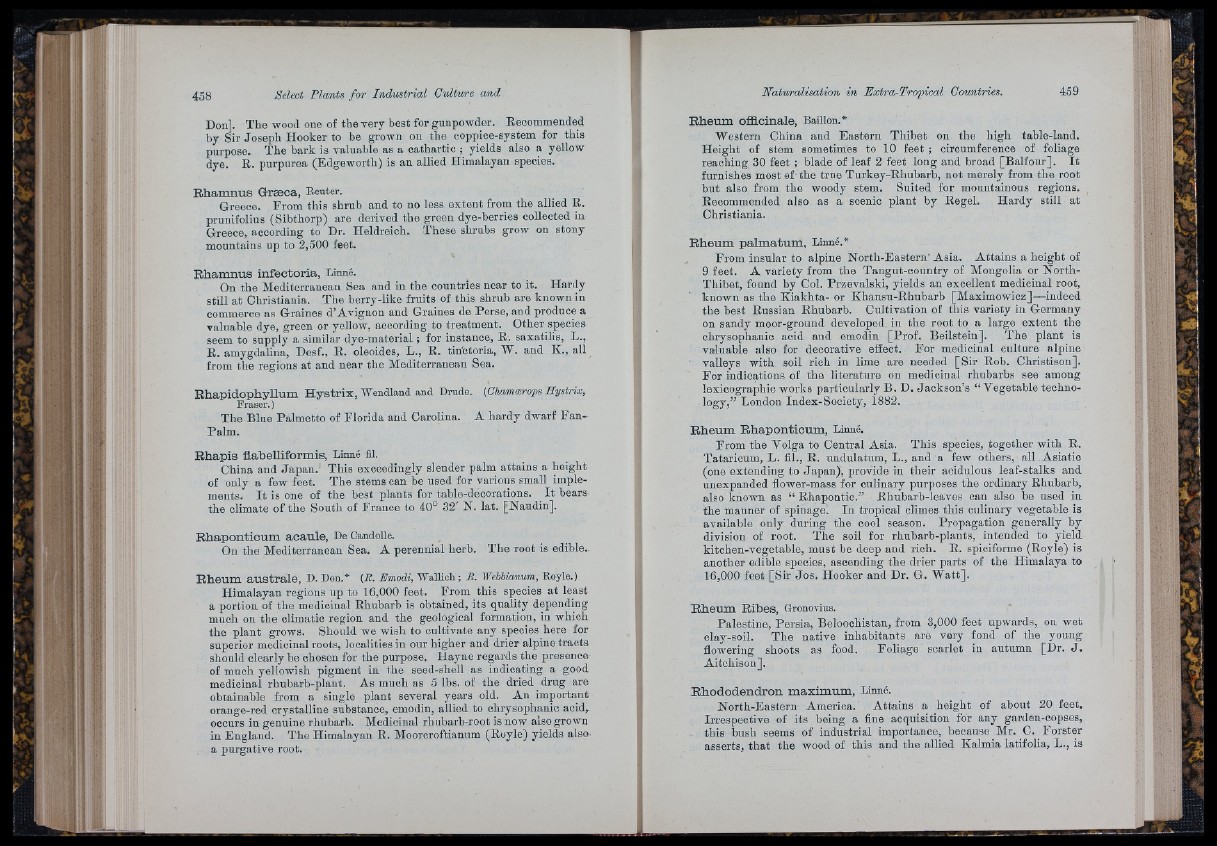
Don]. The wood one of the very best for gunpowder. Eecommended
by Sir Joseph Hooker to be grown on the ooppice-system for this
purpose. The hark is valuable as a cathartic ; yields also a yellow
dye. R. purpurea (Edgeworth) is an allied Himalayan species.
R h a m n u s G ræ c a , Reuter.
Greece. From this shrub and to no less extent from the allied R.
prunifolius (Sibthorp) are derived the green dye-berries collected in
Greece, according to Dr. Heldreich. These shrubs grow on stony
mountains up to 2,500 feet.
R h a m n u s in f e c to r i a , Linné.
On the Mediterranean Sea and in the countries near to it. Hardy
still at Christiania. The berry-like fruits of this shrub are known in
commerce as Graines d’Avignon and Graines de Perse, and produce a
valuable dye, green or yellow, according to treatment. Other species
seem to supply a similar dye-material ; for instance, E . saxatilis, L.,
R. amygdalina, Desf., R. oleoides, L., E. tin'ctoria, W . and K., all
from the regions at and near the Mediterranean Sea.
E h a p id o p h y l lu m H y s t r i x , Wendland and Drude. {Ghamærops Hystrix,
Fraser. )
The Blue Palmetto of Florida and Carolina. A hardy dwarf Fau-
Palm.
R h a p i s ñ a b e llif o rm is , Linné fil.
China and Jap an . This exceedingly slender palm attains a height
of only a few feet. The stems can be used for various small implements.
I t is one of the best plants for table-deoorations. I t bears
the climate of the South of France to 40° 32' N. lat. [Naudin].
R h a p o n t i c u m a c a u le , De Candolle.
Ou the Mediterranean Sea. A perennial herb. The root is edible.
R h e u m a u s t r a l e , D. Don.* (R. Emodi, Wallich; R. Webhianum, Royle.)
Himalayan regions up to 16,000 feet. From this species a t least
a portion of the medicinal Rhubarb is obtained, its quality depending
much on the climatic region and the geological formation, in which
the plant grows. Should we wish to cultivate any species here for
superior medicinal roots, localities in our higher and drier alpine tracts
should clearly be chosen for the purpose. Hayne regards the presence
of much yellowish pigment in the seed-shell as indicating a good
medioinal rhubarb-plant. As much as 5 lbs. of the dried drug are
obtainable from a single plant several years old. An important
orange-red crystalline substance, emodin, allied to chrysophanic acid,
occurs in genuine rhubarb. Medicinal rhubarb-root is now also grown
in England. The Himalayan R. Moorcroftiauum (Royle) yields also-
a purgative root.
R h e u m o ffic in a le . Bâillon.*
Western China and Eastern Thibet on the high table-land.
Height of stem sometimes to 10 feet ; circumference of foliage
reaching 30 feet ; blade of leaf 2 feet long and broad [Balfour], I t
furnishes most of’the true Turkey-Rhubarb, not merely from the root
but also from the woody stem. Suited for mountainous regions.
Recommended also as a scenic plant by Regel. Hardy still at
Christiania.
R h e u m p a lm a tu m , Linné.*
From insular to alpine North-Eastern’ Asia. Attains a height of
9 feet. A variety from the Tangut-country of Mongolia or North-
Thibet, found by Col. Przevalski, yields an excellent medicinal root,
known as the Kiakhta- or Khansu-Rhnbarb [Maximowicz]—indeed
the best Russian Rhubarb. Cultivation of this variety in Germany
on sandy moor-ground developed in the root to a large extent the
chrysophanic acid and emodin [Prof. Beilstein]. The plant is
valuable also for decorative effect. For medicinal culture alpine
valleys with soil rich iu lime are needed [S ir Rob. Christison].
For indications of the literature on medicinal rhubarbs see among
lexicographic works partioularly B. D. Jackson’s “ Vegetable technology,”
London Index-Society, 1882.
R h e u m R h a p o n ti c u m , Linné.
From the Volga to Central Asia. This species, together with R.
Tataricum, L. fil., R. undulatum, L., and a few others, all Asiatic
(one extending to Japan), provide in their acidulous leaf-stalks and
unexpanded flower-mass for culinary purposes the ordinary Rhubarb,
also known as “ Rhapontic.” Rhubarb-leaves can also he used in
the manner of spinage. In tropical climes this culinary vegetable is
available only during the cool season. Propagation generally by
division of root. The soil for rhnbarb-plants, intended to yield
kitchen-vegetable, must be deep and rich. R. spiciforme (Royle) is
another edible species, ascending the drier parts of the Himalaya to
16,000 feet [Sir Jog. Hooker and Dr. G. Wa tt],
R h e u m R ib e s , Gronovius.
Palestine, Persia, Beloochistan, from 3,000 feet upwards, on wet
clay-soil. The native inhabitants are very fond of the young
flowering shoots as food. Foliage scarlet in autumn [Dr. J .
Aitchison].
R h o d o d e n d r o n m a x im u m , Linné.
North-Eastern America. Attains a height of about 20 feet.
Irrespective of its being a fine acquisition for any garden-copses,
this bush seems of industrial importance, because Mr. C. Forster
asserts, th a t the wood of this and the allied Kalmia latifolia, L., is